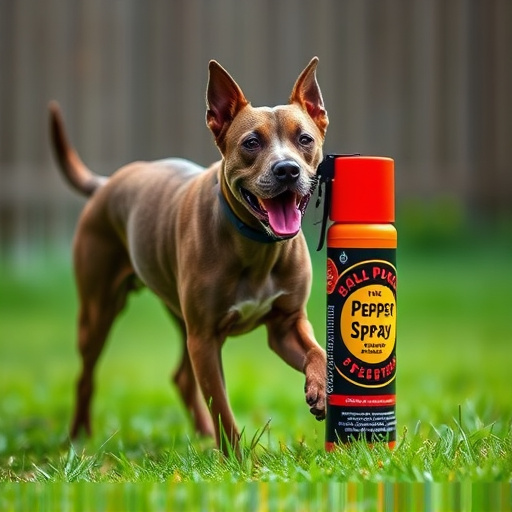Dog spray, a natural defense triggered by fear, releases capsaicin causing temporary blindness and respiratory distress in threats. Safe pepper spray dog defense methods, popular for their non-lethal effect, fit pockets or leashes, offering protection during walks. Training techniques, combined with understanding canine body language, prevent aggression. Legalities vary by region; ensure compliance using approved, animal-safe products.
“Protecting your pet from unexpected animal encounters can be a challenging yet crucial task for any responsible owner. In this article, we explore effective and safe pepper spray dog defense methods, offering practical solutions for enhancing their safety on walks or in public spaces. From understanding the causes and effects of animal aggression to examining non-lethal options and legal considerations, we provide comprehensive insights into pocket-size solutions for dog safety.”
- Understanding Animal Spray: Causes and Effects
- Pocket-Size Solutions for Dog Safety
- Non-Lethal Options for Effective Defense
- Training Techniques to Deter Aggression
- Legal Considerations: Using Spray on Pets
Understanding Animal Spray: Causes and Effects
Animal spray, often referred to as dog spray or pepper spray, is a natural defense mechanism employed by certain animals, primarily dogs, when they feel threatened or cornered. This potent substance is released from specialized glands and can have significant effects on potential predators or perceived dangers. Understanding the causes and outcomes of animal spray is crucial in implementing safe pepper spray dog defense methods.
The primary cause of animal spray is fear or distress. Dogs may release this powerful liquid as a warning signal to potential threats, aiming to deter or discourage an attack. The spray contains capsaicin, the same compound found in hot peppers, which activates pain receptors in the eyes and respiratory system of the target. This stimulation leads to temporary blindness, intense irritation, coughing, and difficulty breathing, providing the dog with valuable time to escape or defend itself. Knowing these causes enables pet owners and enthusiasts to employ appropriate strategies to minimize encounters that may result in animal spray exposure.
Pocket-Size Solutions for Dog Safety
Staying safe while out with your dog is a top priority for any pet owner. One innovative solution gaining traction is the use of pocket-size, dog-specific spray defense methods. These compact devices pack a punch when it comes to protecting both you and your furry companion from potential threats.
Safe pepper spray designed for dogs offers a non-lethal yet effective way to deter aggressive encounters. Weighing less than a handful, these portable sprays can easily fit in a pocket or attach to a leash for quick access. Their compact size ensures that dog owners are prepared without compromising on mobility or convenience during walks, hikes, or any outdoor activity with their pets.
Non-Lethal Options for Effective Defense
Many pet owners are seeking non-lethal options for protecting their dogs from potential threats, especially in situations where a quick response is needed. Safe pepper spray dog defense methods have gained popularity as an effective and humane alternative to traditional weapons. These pocket-size sprays are designed to temporarily incapacitate an aggressor without causing permanent harm.
Unlike conventional pepper spray used by law enforcement, dog defense variants are specifically formulated for minimal impact on the animal’s well-being. They utilize capsaicin, the active ingredient in chili peppers, which triggers a burning sensation and irritates the eyes and respiratory system. This temporary disorientation allows pet owners to safely separate their dogs from potential danger, providing them with a crucial moment to assess the situation or seek help.
Training Techniques to Deter Aggression
Training techniques play a pivotal role in deterring aggression from dogs, especially when it comes to protecting yourself with safe pepper spray dog defense methods. Positive reinforcement is a powerful tool; rewarding good behavior and remaining calm during potential trigger situations can help prevent aggressive responses. This involves teaching your dog alternative behaviors to replace aggression, such as sitting or rolling over, which are met with praise and treats.
Consistency is key; regular practice of these training sessions will reinforce the desired behaviors, making them more likely to respond positively in stressful situations. It’s also crucial to understand a dog’s body language to detect early signs of aggression, allowing you to employ safe pepper spray defense methods as a last resort when other deterrents fail.
Legal Considerations: Using Spray on Pets
Using pepper spray as a defense method for pets, especially dogs, is a topic that requires careful consideration of legal aspects. In many regions, pepper spray is regulated and its use on animals is subject to specific laws and guidelines. While some areas allow the use of safe pepper spray dog defense methods for self-protection against aggressive canines, others have stringent restrictions.
It’s crucial to understand local regulations before employing this strategy. Using pepper spray on a pet should be a last resort when all other non-lethal training and prevention techniques have been exhausted. Pet owners must ensure they are complying with the law and using approved products designed for animal safety to avoid legal repercussions and potential harm to their pets.
When it comes to protecting your pet from potential threats, considering safe pepper spray dog defense methods can offer a valuable non-lethal option. By understanding animal spray behavior and employing pocket-size solutions like compact pepper spray designed for dogs, you can ensure your furry friend’s safety during outdoor adventures. Combining these practical tools with training techniques aimed at deterring aggression provides a comprehensive approach to safeguarding your canine companion in various situations. Remember, staying informed about legal considerations related to using spray on pets is essential for responsible ownership.
